 | George Mikan, a famous Croatian-American basketball player, the first big and dominant man in the NBA (212 cm tall). He was born in Joliet, and baptized in the Croatian Roman Catholic Church in. His grandfather, whose name is also George Mikan, was born in Croatia, as Juraj Mikan (in Croatian, Juraj = George), and he once said th efollowing: "I am proud of my grandson, and am glad that we Croatians have made a contribution to the progress and development of our America, not only in its industry, but in its sporting world, also." A statue was erected in honor of the NBA Hall of Famer at the Target Center in Minneapolis. In 2013 his two grand-daughters, Gina and Molly, visited Croatia and, among others, payed a visit to the native village of George Mikan's grand-father, and to their relatives - Mikans in Croatia. |
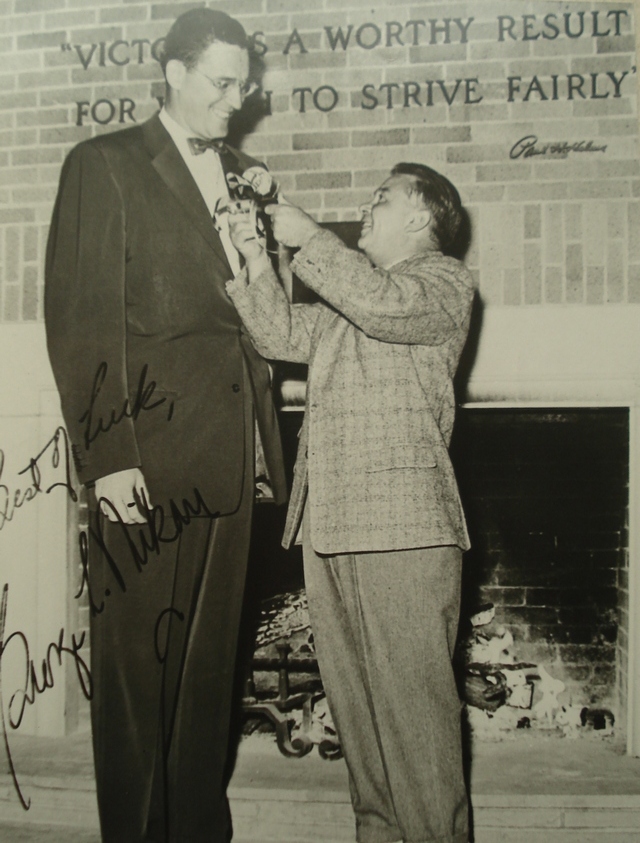
One would say that he is a university professor, rather than a professional basketball player.
Bill Schroeder presents Helm Medallion noting Mikan's election into Helms athletic foundation Hall of Fame.
Photo by Green & Tillisch, courtesy: First Interstate Bank Athletic Foundation - Sports Museum.
Many thanks to Mr. Vladimir Novak, Croatia/USA, for the photo.
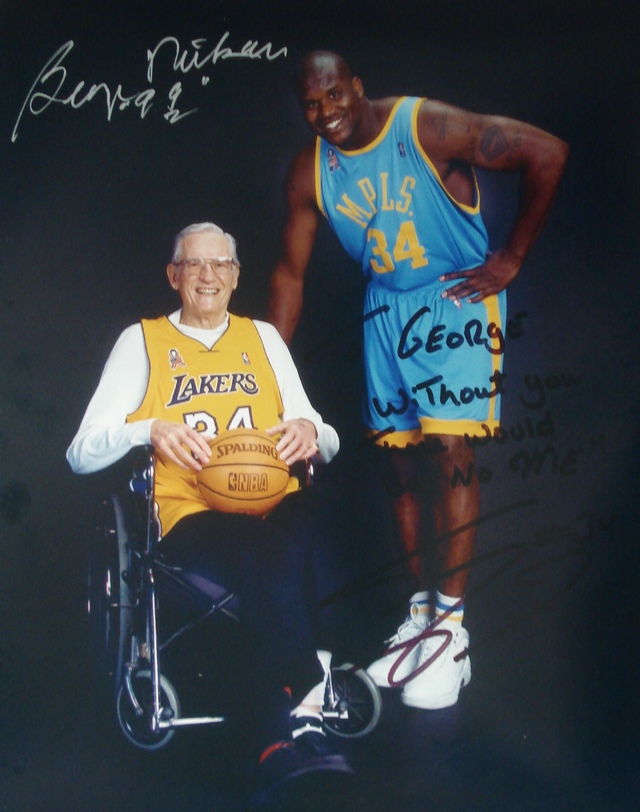
Shaquil wrote the following dedication: To George, without you there would be no me.
I am obliged to Ms. Gina Mikan, George Mikan's grand-daugher, for briniging this very nice photo as a gift to Zagreb.

At the left is Joe, in the middle is Mr. Mikan, in front of him is Eddie, and on the right is the famous player George.
George Mikan, on the right, is behind his grandfather, also named George Mikan, born in Croatia, in Vivodina, as Juraj Mikan (Juraj = George).
Many thanks to Mr. Vladimir Novak for the copy of the article, containing this photo. It was published in
The American Croatian HISTORICAL REVIEW, in the article that we enclose below.
| The American Croatian HISTORICAL REVIEW, July 1946 George Mikan George MIKAN, the famous athlete, was born in Joliet, Illinois, of Croatian ancestry. His grandfather, George Mikan, who is now seventy-two years of age, conducts his own restaurant, the Geo. Mikan Restaurant, serving excellent food, at 2601 Broadway, Joliet, Illinois, with the help of his wife Mary, and his grandsons. The family also owns the Mikan Skating Rink in Joliet, which can accomodate from 300 to 500 persons. When a representative of the American Croatian Historical Review visited Mr. Mikan last month for the purpose of obtaining information concerning his famous grandson, Mr. Mikan told him the following story: "I was born seventy-two years ago in the village of Vivodina, near Jaske, Croatia. I left my native country and came to Braddock, Pennsylvania, in 1891, and obtained work in nearby Rankin. I planned to stay in America for a short time, then to return to Croatia. However, I changed my mind and decided to marry and to stay in the United States. I was married in 1906 by Father Bozic in the St. Nicholas Croatian Roman Catholic Church of Allegheny, Pennsylvania. On October 17, 1907, a son was born to us, and soon thereafter we moved to Joliet, where we have remained since." At this point Mr. Mikan motioned toward the trophies won by his grandson George. These were lying on the counter, but he stated: "There are more of them, but George has them somewhere." He handede them to the representative, one by one, who made a record of the inscriptions engraved on the trophies.
After the notation of the trophies were recorded, and after Mr. Mikan had replaced them, he procured a picture of George, which we are reporducing, and a snapshot taken seventeen years ago, stating: "This is me with my three grandsons, Joe, George, and Eddie." Mr. Mikan continued: "My son, the father of George, is working at the Common Pleas Court here in Joliet. His sons, three of them, with a daughter, are all with us, as one family." "By the way," exclaimed Mr. Mikan, "my son married a Lithuanian girl, Minnie." When he was asked about the childhood and schooling of George, Mr. Mikan replied: "George was born in Joliet, and was baptized in the Croatian Roman Catholic Church. He wnt to St. Joseph's School, and then to the Croaitan Catholic School. " From there he went to Moren Public High School, and after the completion of that term he went to the Metropolitan Business College, where he studied typing and shorthand. It was our wish that George become a priest, and we enrolled him in the Quigle Preparatory Seminary, where he spent four years. When the time came that he should enter school at the Mundelein St. Mary of the Lake Seminary, he chose instead De Paul University, where he has been ever since." He continued, "I am proud of my grandson, and am glad that we Croatians have made a contribution to the progress and development of our America, not only in its industry, but in its sporting world, also." The Review is proud to be able to publish this short sketch about such a great athelete as George Mikan, and his family. Many thanks to Mr. Vladimir Novak, Croatia/USA, for the copy of this article. According to his personal information, the article was published in The American Croatian HISTORICAL REVIEW in July 1946. Only five or six issues of the journal have been published. The journal can be seen at Croatian Ethnic Institute in Chicago. This very nice journal, published by The Croatian Historical Research Bureau, Youngstown, Ohio, was founded by Clement Mihanovich, professor at St. Louis University, St. Louis, Missouri. MIHANOVICH, CLEMENT Professor-Author Clement Simon Mihanovich was born in St. Louis, Missouri on April 3, 1913. From 1919 to 1927 he attended St. Joseph's Croatian Grammar School. From 1927 to 1931 he attended William Cullen McBride High School in St. Louis, Missouri. In the year 1931 he enrolled in the School of Education of St. Louis University from which he graduated with the degree of B. S. in Education in the year 1935. enrolled in the Graduate School of St. Louis University in the year 1935. His Thesis at St. Louis University was Americanization of the Croatians in St, Louis, Missouri During the Past Thirty Years. Source: late Adam Eterovich Below this article follows another one, entitled "Rescue On The Atlantic", describing how a Croatian bark named HERVATSKA, that is, CROATIA, sailing on February 2, 1882 from Philadelphia to Dalmatian ports, saved a crew of the English vessel, the CHEROKEE OF GREENOCK, during a desastrous storm in the Atlantic. It obtained a recognition of the English Queen. The bark was a property of the Senj Navigation Corporation (Senj is a Croatian port in the Adriatic Sea), built in 1874. |

The American Croatian HISTORICAL REVIEW, July 1946, contains the above very nice article about George Mikan.
On the front page we can see the father of petroleum engineering, distinguished Croatian-American researcher Anthony F. Lucas (Antun Lučić).
Contents: Editorial. Acknowledgments and preface. The Birth of A Great Discoverer (Captain Francis Stephen Lucic / Lucas,
discoverer of petroleum at Spindletop in Texas). The Pride of Every Croatian and Slav
(George Mikan, basketball player). Rescue on the Atlantic (Croatian bark Hervatska and its rescue
of the crew of the English vessel Cherokee of Greenock). ; 11.0" tall; 16 pages.
NBA Legends about THE FIRST NBA LEGEND - George Mikan

enjoying in Zagreb. Gina and Molly are sisters, born and living in Minneapolis, USA, and grand-daughters of great George Mikan.
Mrs. ®eljka Mikan is their distant relative, born and living in Croatia. In 2013 Molly and Gina visited Croatia and a village near the town of
Vivodina, SW of Zagreb, where ®eljka's parents live, and from where George Mikan's grandfather originates.

Car route from Croatia's capital Zagreb to the village of Vivodina,
the place where George Mikan's grandfather Juraj Mikan was born.

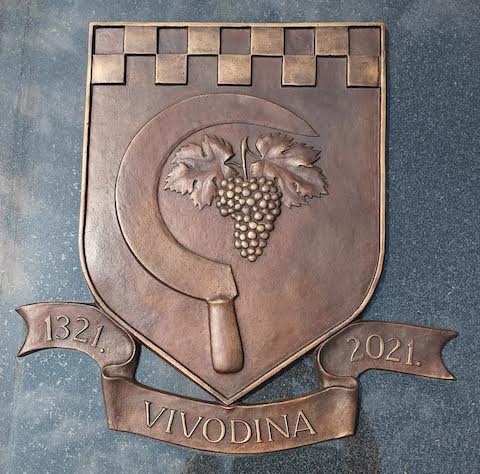


Please, go to the next page below.

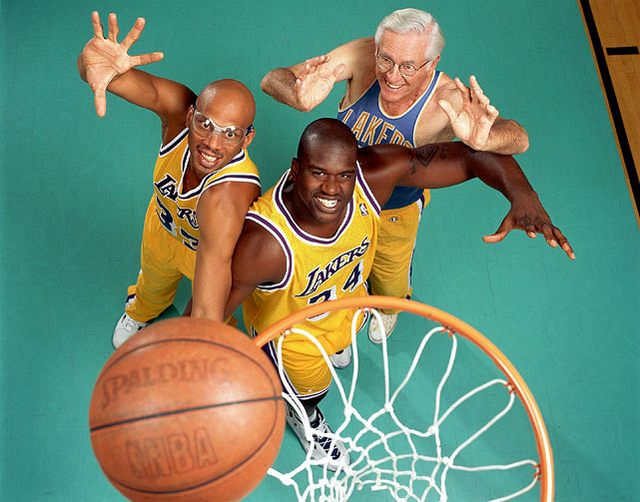
| GEORGE MIKAN In the game of basketball, before there was Michael Jordan, Larry Bird, or Magic Johnson, there was George Mikan. Known as the first NBA superstar, George Mikan dominated the game throughout his entire career. As a center for the Minneapolis Lakers in the 1940's and 50's, George Mikan led his team to six professional basketball titles in seven years and a place in NBA history as the NBA!s first dynasty team. Born on June 18, 1924 in depression-era Joliet, Illinois, George (along with his two brothers Joe and Ed and sister Marie) worked as a child in Mikan’s Tavern, his grandparents' restaurant situated near the industrial part of town. "My hardworking parents were named Joseph and Minnie", Mikan says. Mikan's grandparents had immigrated to the United States in the early 1900's from Vivodina, Croatia. George Mikan's grandfather Juraj, after whom he is named George, originally left Croatia alone to earn enough money to bring over his wife Marija. He settled in Pittsburgh and went to work in the steelmills. Within three weeks he made enough money to send for Marija. Shortly thereafter, the Mikan family moved to Illinois where the grandfather eventually bought their combination tavern and restaurant at the comer of Elsie Avenue and North Broadway in Joliet. "Gramps and Dad took care of the tavern business and tended bar until the three of us boys were old enough to see over the bar" remembers Mikan. "Mom was the restaurant cook. Her 35-cent fried chicken became a staple of the community. We kids did everything else at Mikan's Tavern from waiting on tables to cleaning fish for our weekly Friday night fish dinners." When he grew to six feet tall at age 11, George began to get involved in basketball. Remembering his grandmother at that time, Mikan states, "Although Grandma didn't know the rules of basketball, she knew when something wasn!t right. She decided all the court squabbles with the end of her broomstick." Mikan attended seven years of grammar school at St. Mary's Croatian School in Joliet. At age 12, Mikan went on to Joliet Catholic High School but soon transferred to Quigley Prep Seminary School after being cut from the Joliet basketball team because of his poor vision. "Quigley was a training ground for future priests on the north side of Chicago located 50 miles from my home" Mikan explains.,"I was able to transfer there thanks to my mom and Fr. Violich, the parish priest at St. Mary's Croatian School. Father Violich thought I would make a good priest, and my mother and grandmother agreed." At Quigley Seminary, Mikan studied for the priesthood, but his height, six and a half feet at the age of 16, drew him deeper into the basketball program at which he excelled. After graduating from Quigley, George accepted a scholarship offer and committed to De Paul University where he played under coaching great Ray Meyer. While at De Paul, Mikan (then six feet, ten inches) led his team to an 81-17 record and won the NIT Championship in 1944. Individually, Mikan was All-American First Team, Player of the Year, NIT All Star, and NIT Most Valuable Player. After graduating from De Paul, Mikan married his sweetheart Patricia, obtained his law degree, and began playing professional basketball for the Chicago American Gears of the National Basketball League. When the league folded, Mikan signed with the Minneapolis Lakers. At this point, his career really took off. With the Lakers, Mikan won six NBA championships, was a five time NBA All Star, led the league in scoring for five consecutive years, was voted Mr. Basketball of the First Half of the Century, and was enshrined into the NBA Hall of Fame. After retiring from basketball in 1956, George Mikan was involved in a number of business ventures. He quickly turned his eye to politics and ran for Congress in 1956. At age 31, Mikan was new to the political arena but he displayed the same determination and hard work that he displayed on the basketball court. Mikan easily won the Republican nomination and gave the 15-year incumbent Democrat a run for his money. When all the votes were counted, George had lost by half of I percentage point, one of the closest races in the history of Minnesota. Eventually George started a successful travel agency. This success allowed him to return to basketball as the first Commissioner of the American Basketball Association (ABA), and he worked in the front office of the Minnesota Timberwolves. Today, at age 75 [that is, in 2000; D.®.], George and his wife Pat relax in Minnesota, where they have lived with their six children since George's first years with the Lakers. Adam Eterovich Bracanin |

| George Mikan 1924-2005 Mikan was so dominant that he caused several rule changes in the NBA, among them widening the foul lane—known as the "Mikan Rule" — and introducing the shot clock. George Mikan was born in Joliet, Illinois, as an American of Croatian descent. As a boy, he shattered his knee so badly that he was kept in bed for a year and a half. In 1938, Mikan attended the Chicago Archbishop Quigley When Mikan entered Chicago's DePaul University in 1942, he stood 6' 10", weighed 245 pounds, moved awkwardly because of his frame, and wore thick glasses for his near-sightedness. However, Mikan met 28-year-old rookie DePaul basketball coach Ray Meyer, who saw potential in the bright and intelligent, but also clumsy and shy freshman. Put into perspective, Meyer's thoughts were revolutionary, because at the time it was believed that tall players were too awkward to ever play basketball well. In the following months, Meyer transformed Mikan into a confident, aggressive player who took pride in his height rather than being ashamed of it. Meyer and Mikan worked out intensively, and Mikan learned how to make hook shots accurately with either hand. This routine would become later known as the Mikan Drill. In addition, Meyer made Mikan punch a speed bag, take dancing lessons and jump rope to make him a complete athlete. From his first National Collegiate Athletic Association (NCAA) college games for DePaul on, Mikan dominated his peers. He intimidated opponents with his size and strength, was unstoppable on offense with his hook shot, and soon established a reputation as one of the hardest and grittiest players in the league, often playing through injury and punishing opposing centers with hard fouls. In addition, Mikan also surprised the basketball world by his unique ability of goaltending, i.e. jumping so high that he swatted the ball away before it could pass the hoop. In today's basketball, touching the ball after it reaches its apogee is forbidden, but in Mikan's time it was legal because people thought it was impossible anyone could reach that high. "We would set up a zone defense that had four men around the key and I guarded the basket," Mikan later recalled his DePaul days. "When the other team took a shot, I'd just go up and tap it out." As a consequence, the NCAA and later the NBA outlawed goaltending. Mikan was named the Helms NCAA College Player of the Year twice in 1944 and 1945 and an All-American three times, leading DePaul to the NIT title in 1945, which was the same as an NCAA championship back in 1945. Mikan led the nation in scoring with 23.9 points per game in 1944–45 and 23.1 in 1945–46. When DePaul won the 1945 National Invitation Tournament, Mikan was named Most Valuable Player for scoring 120 points in three games, including 53 points in a 97–53 win over Rhode Island, equalling the score of the entire Rhode Island team. Mikan is lauded as the pioneer of Modern Age basketball. He was the original center, who scored 11,764 points, an average of 22.6 per game, retired as the all-time leading scorer and averaged 13.4 rebounds and 2.8 assists in 520 NBL, BAA and NBA games. As a testament to his fierce playing style, he also led the league three times in personal fouls.[2][5] He won seven NBL, BAA, and NBA championships, an All-Star MVP trophy, and three scoring titles, and was a member of the first four NBA All-Star games and the first six All-BAA and All-NBA Teams. As well as being declared the greatest player of the first half of the century by The Associated Press, Mikan was on the Helms Athletic Foundation all-time All-American team, chosen in a 1952 poll, was inducted into the Basketball Hall of Fame in 1959, made the 25th and 35th NBA Anniversary Teams of 1970 and 1980 and was elected one of the NBA 50 Greatest Players in 1996.[1][2][5] Mikan's impact on the game is also reflected in the Mikan Drill, today a staple exercise of "big men" in basketball. When superstar center Shaquille O'Neal became a member of the Los Angeles Lakers, Sports Illustrated graced its November 1996 issue with Mikan, O'Neal and fellow Lakers legend Kareem Abdul-Jabbar, calling Abdul-Jabbar and Mikan the "Lakers legends" to whom O'Neal was compared. Since April 2001, a statue of Mikan shooting his trademark hook shot graces the entrance of the Minnesota Timberwolves' Target Center.[2] In addition, a banner in the Staples Center commemorates Mikan and his fellow Minneapolis Lakers. He is also honored by a statue and an appearance on a mural in his hometown of Joliet, Illinois. Mikan became so dominant that the NBA had to change its rules of play in order to reduce his influence such as widening the lane from six to twelve feet ("The Mikan Rule"). He also played a role in the introduction of the shot clock, and in the NCAA his dominating play around the basket led to the outlawing of defensive goaltending. Mikan was a harbinger of the NBA's future, which would be dominated by tall, powerful players. As an official, Mikan is also directly responsible for the ABA three-point line, which was later adopted by the NBA, the multi-colored ABA ball, which still lives on as the "money ball" in the NBA All-Star Three Point Shootout, and the existence of the Minnesota Timberwolves. In 1947, he married his girlfriend Patricia, who remained his wife the next 58 years until he died. Mikan fathered six children, sons Larry (George Lawrence Mikan III), Terry, Patrick and Michael and daughters Trisha and Maureen. All his life, Mikan was universally seen as the prototypical "gentle giant", tough and relentless on the court, but friendly and amicable in private life. He was also the older brother of Ed Mikan, another basketball player for both DePaul and the BAA. Shaquille O'Neal offered to pay for Mikan's funeral. He said: "Without number 99 [Mikan], there is no me." Before Game 5 of the 2005 Eastern Conference Finals between the Heat and the Detroit Pistons, there was a moment of silence to honor Mikan. Bob Cousy remarked that Mikan figuratively carried the NBA in the early days and single-handedly made the league credible and popular. Source georgemikan.com |
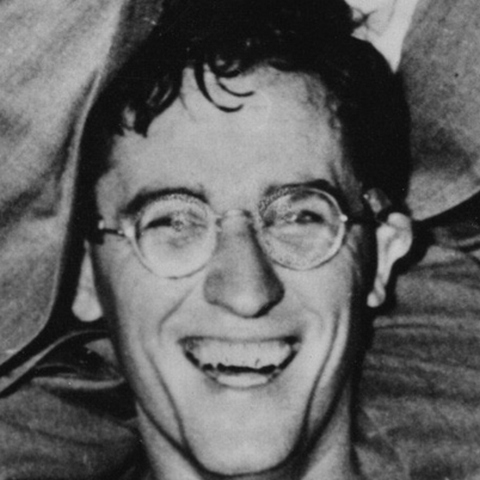




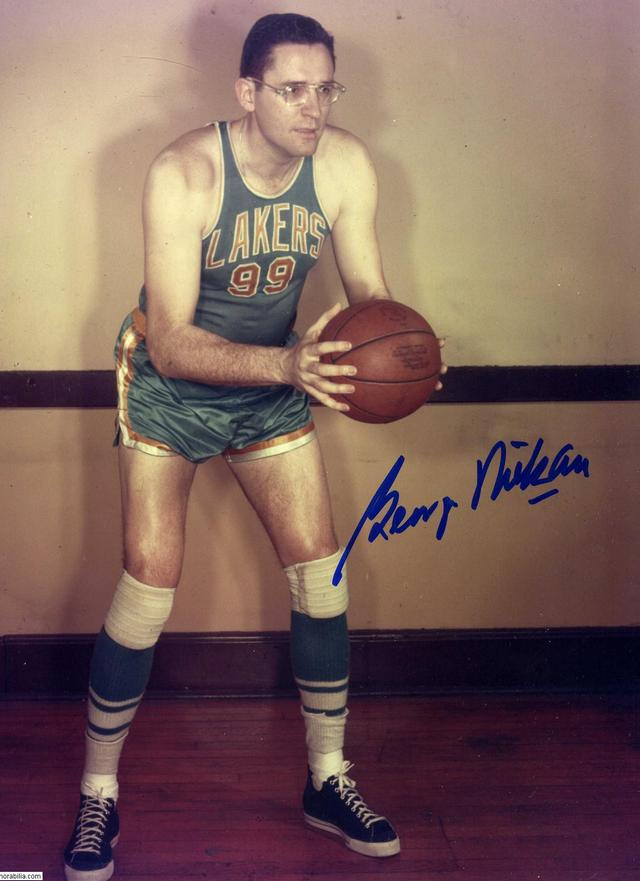
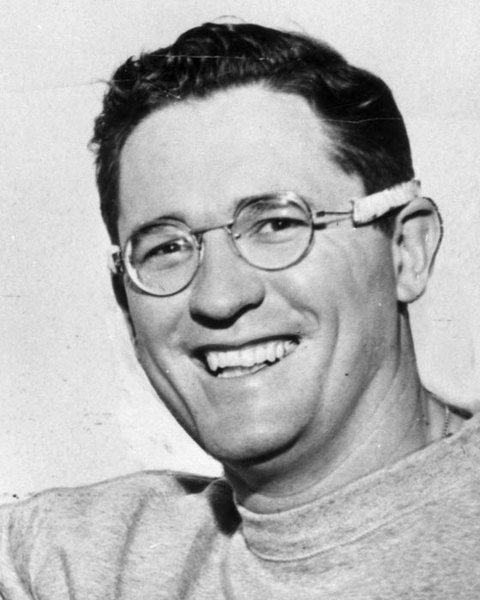
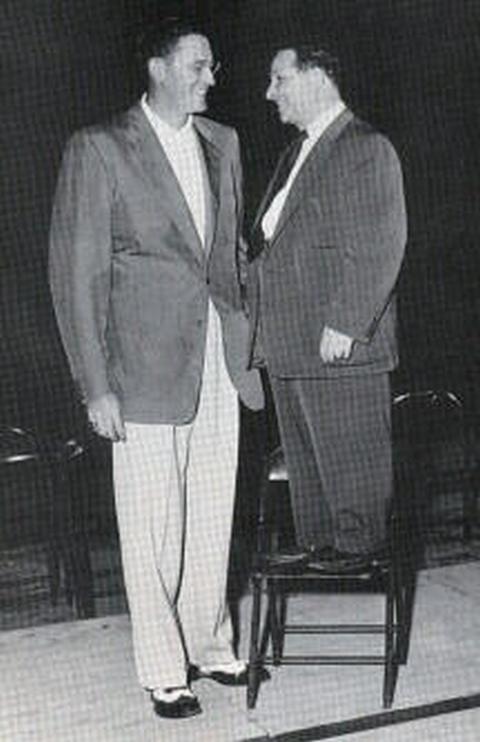

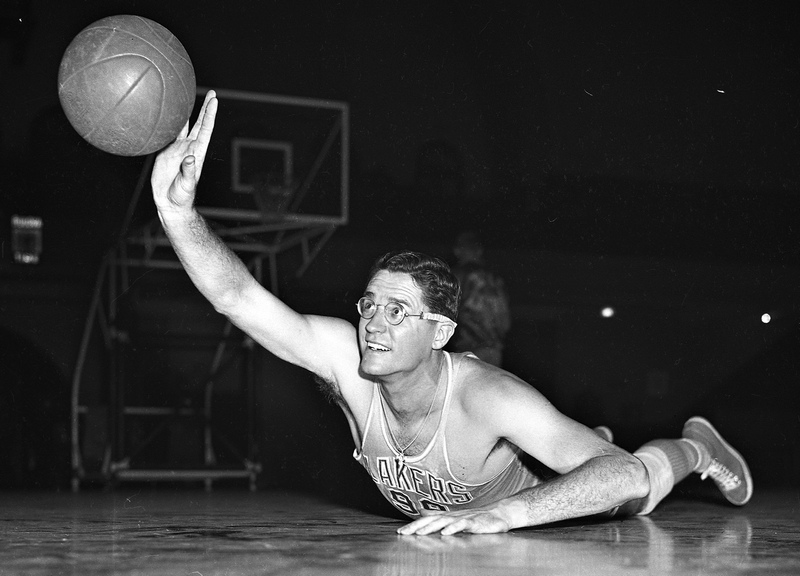
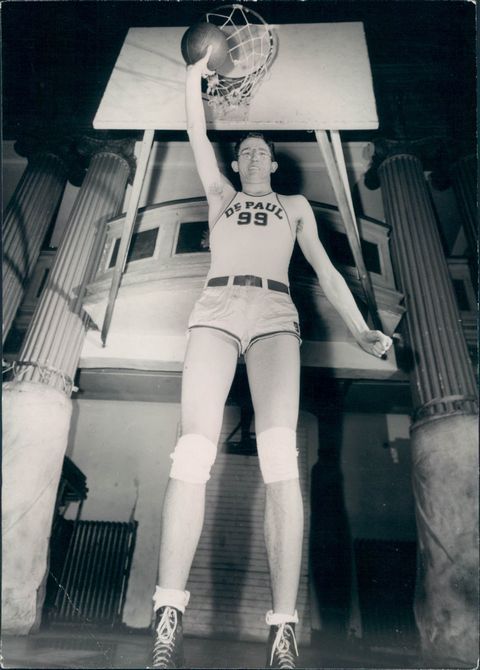
| GEORGE MIKAN It's hard to believe today, but until the 1940s basketball was considered a sport better suited to shorter men than to taller, less nimble players. George Mikan, a 6-10 giant of a man who possessed superior coordination and a fierce competitive spirit, was one of the prototypes for the dominating tall players of later decades. Towering over most of his competitors, he was one of the most effective scorers of his day, averaging 22.6 points over a professional career that lasted nine years -- one with the Chicago American Gears and eight with the Minneapolis Lakers. Mikan was so hard to defend and to score against, in fact, that the NBA had to change its rules of play in order to keep him from completely overwhelming the league. Few players have had such a huge impact on the game. In 1950, Mikan was voted the greatest player of the first half of the century by The Associated Press. GEORGE MIKAN Full Name: George Lawrence Mikan Jr. Born: 6/18/24 in Joliet, Ill. Died: 6/1/05 in Scottsdale, Ariz. College: DePaul Signed by: Chicago American Gears of the NBL (1948) Height: 6-10; Weight: 245 lbs. Honors: NBL Honors: NBL champion ('47, '48); MVP ('48); All-NBL First Team ('47, '48). BAA Honors: BAA champion (1949); All-BAA First Team (1949). Elected to Naismith Memorial Basketball Hall of Fame (1959); NBA champion (1950, '52, '53, '54); Five-time All-NBA First Team (1950-54); Four-time NBA All-Star (1951-54); All-Star MVP (1953); One of 50 Greatest Players in NBA History (1996). In his nine professional seasons -- two in the National Basketball League, one in the Basketball Association of America, and six in the NBA -- Mikan's teams won seven championships. He was the cornerstone of the NBA's first dynasty, the Minneapolis Lakers of the early 1950s. Mikan led the NBA in scoring three times and in rebounding average twice and he played in the league's first four All-Star Games. The notion that someone could be tall enough, and jump high enough, to deflect a ball while it was above the basket was unthinkable before the 1940s. But that changed when Mikan perfected the art of goaltending -- then a perfectly legal practice because it was considered impossible when he played college ball. "We would set up a zone defense that had four men around the key and I guarded the basket," Mikan recalled. "When the other team took a shot, I'd just go up and tap it out." He swatted away so many would-be baskets at DePaul that the NCAA decided to outlaw goaltending. Named College Player of the Year twice and an All-American three times, Mikan led DePaul to the NIT title in 1945. En route to the championship, he broke the collegiate single-game scoring record by pumping in 53 points against Rhode Island State -- a remarkable feat at the time, and made even more amazing by the fact that he single-handedly outscored the entire Rhode Island State team. Mikan's debut as a professional came in 1946 after he was signed by the Chicago American Gears of the NBL, a predecessor of the NBA. Dominating the pro players as devastatingly as he had college players, Mikan scored 16.5 points per game in his rookie year, powered his team to victory in the league championship and was named to the All-NBL Team. Before the start of the 1947-48 campaign, Maurice White, president of the American Gear Company and owner of the Chicago team, pulled the club out of the NBL. White's plan was to create a 24-team circuit called the Professional Basketball League of America, in which he would own all of the teams and all of the arenas. But the new league lasted barely a month, and the players on White's teams were distributed among the 11 remaining NBL franchises. The first-year Minneapolis Lakers landed Mikan strictly by chance. Wearing a Lakers uniform in 1947-48, Mikan joined forward Jim Pollard to form an imposing Minneapolis front line. The Lakers dominated the NBL's Western Division, then rolled through the playoffs, winning a best-of-five championship series against the Rochester Royals in four games. After averaging 21.3 ppg in the regular season, Mikan poured in 27.5 points ppg in the Finals. Before the 1948-49 season began, the Minneapolis Lakers, Rochester Royals, Fort Wayne Zollner Pistons and Indianapolis Kautskys (later renamed the Jets) had defected to the Basketball Association of America. The BAA was already a big-city, eight-team league with franchises in New York, Boston, Philadelphia and Chicago. And the addition of the four NBL teams gave the league the big-name players it needed. Rochester and Minneapolis dueled for the top spot in the BAA's Western Division in 1948-49, but the Royals edged out the Lakers by one game, even though the broad-shouldered and extremely agile Mikan played with devastating force. He put up numbers that, by the standards of the day, were unbelievable. His league-leading average of 28.3 ppg accounted for one-third of the Lakers' point production. Only two other players in the league, Joe Fulks of Philadelphia and Max Zaslofsky of Chicago, managed to average more than 20 points. In the 1949 BAA Playoffs, the Lakers advanced all the way to the Finals, where they faced the Washington Capitols, who were coached by Red Auerbach. Minneapolis notched three quick wins to open the best-of-seven series. In Game 4, Mikan sustained a broken wrist, and the Capitols escaped with a win. Mikan played Game 5 with a cast on his hand and pumped in 22 points, but Washington prevailed. Game 6 was played in St. Paul, where Minneapolis came away with a 77-56 victory and a BAA Championship. In 10 postseason contests, Mikan averaged 30.3 ppg. The BAA and the NBL merged after that season, and the NBA was born for the 1949-50 campaign. In its first year, the NBA consisted of 17 teams competing in three divisions. Minneapolis was assigned to the Central Division (the strongest of the new circuit), where it went head-to-head once again with Rochester. Mikan topped the new league in scoring by averaging 27.4 ppg. Only Alex Groza of Indianapolis joined him in the 20-plus bracket. Minneapolis, which finished the regular season at 51-17, waltzed through the preliminary rounds of the postseason. The powerful Lakers felled the Chicago Stags in the Central Division Semifinals, swept the Fort Wayne Pistons in two games in the division finals and then dusted the Anderson Duffey Packers in two games in the NBA Semifinals. George Mikan was honored in 2001 with a statue at the Target Center in Minneapolis. The NBA Finals in 1950 pitted the Lakers against the Syracuse Nationals. The Nats had the home-court advantage, but the Lakers took Game 1 in Syracuse when reserve guard Bob Harrison heaved in a 40-foot shot at the buzzer to give Minneapolis a two-point win. The Nationals evened the series the next night. When the Finals reconvened in Minnesota five days later, Minneapolis pounded out a 91-77 win, then followed with another victory in Game 4. Syracuse postponed the inevitable by shutting down Mikan in Game 5, but the Lakers came back with a 110-95 victory in Game 6, thereby earning the team's second straight championship. Mikan poured in 31.3 ppg in the playoffs. The NBA began keeping track of rebound statistics in the 1950-51 season. Mikan was among the league's premier rebounders, pulling down an average of 14.1 rebounds per game, second only to Dolph Schayes's 16.4 rpg. But Schayes couldn't match Mikan in the scoring department, as the Lakers' center turned in a career-best average of 28.4 ppg, tops in the NBA. For the first time since Mikan had begun playing professional basketball, his team did not win a championship. Minneapolis fell to Rochester in the Western Division Finals, three games to one, largely because Mikan hobbled through the series with a fractured leg. "The doctors taped a plate on it for the playoffs," Mikan told Newsday in 1990. "I played all right, scored in the 20s. I couldn't run, sort of hopped down the court." Injured or healthy, Mikan was in his prime. Unlike other players in the league, he was able to draw large crowds wherever he went. People clamored to watch the bespectacled Goliath play with the grace and agility of men a foot shorter. From 1949 to 1954 he was named the center on the All-NBA First Team. He starred in the first four NBA All-Star Games, from 1951 to 1954, including a 26-point, 15-rebound performance in the 1952 contest. He could deliver hook shots with deadly accuracy using either hand. His two-handed set shot, the standard shot of his era, was usually on the money. And he could run the floor with surprising speed. On both ends of the court, Mikan's style of play could be categorized as hard-nosed, as evidenced by the 10 broken bones he suffered and the 16 stitches he required during his playing years. As another sign of his rugged play, Mikan earned a place in the NBA record books by retiring with the most seasons (3) in which he led the league in personal fouls. One of the legendary stories about Mikan concerns a game played on Dec.13, 1949, between the Lakers and the Knicks. The marquee over Madison Square Garden read: "Geo. Mikan vs. Knicks." When Mikan walked into the locker room before the game, he found his teammates sitting around in their street clothes. One of them greeted Mikan by saying, "They're advertising you're playing against the Knicks, so go play them. We'll wait here." Mikan did seem to single-handedly overpower the rest of the league at times, so much so that the NBA tried to make it more difficult for him to score by expanding the width of the key, from 6 feet to 12 feet. The 24-second clock also came about because of Mikan. In a game in 1950, the Fort Wayne Pistons decided that the only way they could win was to hold onto the ball and not let the Lakers have it. They ended up winning, 19-18, in the lowest-scoring game in NBA history. The league implemented the 24-second shot clock a few seasons later. 1953-54 Lakers George Mikan (No. 99) was the lynchpin of the 1953-54 World Champion Minneapolis Lakers. NBA Photos In the 1951-52 season, Mikan finally began his slow descent from the league's scoring pinnacle. His average of 23.8 ppg was almost five points lower than what it had been the previous year and his field-goal percentage dipped to .385 (from .428 the year before). One reason his production decreased was the rule change that widened the foul lane. Before that season, Mikan and other centers would play the pivot position almost directly underneath the basket, where the giants were particularly deadly when they got the ball. Even with Mikan's decreased scoring contribution, he was still among the league's best rebounders, pulling down 13.5 rpg in 1951-52. And he still knew how to win. The Lakers regained the NBA crown in 1952, defeating the New York Knicks in a seven-game NBA Finals. Although Mikan's point production continued to slide in 1952-53, he was still second in the league in scoring with an average of 20.6 ppg. It was also the only year he led the NBA in rebounding (based on total rebounds), posting a career-high 14.4 rpg average. In that year's All-Star Game, Mikan dominated the backboards and won the game's MVP Award. The Lakers were the class of the league again in 1953, winning a second straight championship with a five-game triumph over New York. Mikan led the Lakers to yet another championship in 1954, marking their third straight crown and fifth in six seasons. Only the Boston Celtics (1959 to 1966) and the Chicago Bulls (1991 to 1993) would win three consecutive championships in the second half of the century (the Los Angles Lakers began the next century with three consecutive titles as well winning the NBA Finals 2000-2002. During the regular season Mikan, then 29 years old, ranked fourth in the NBA in scoring (18.1 ppg) and second in rebounding (14.3 rpg). Mikan stunned the basketball world by announcing his retirement after the Lakers' 1954 championship run. "I had a family growing, and I decided that I wanted to be with them," he said. "I felt it was time to get started with the professional world outside of basketball." With Mikan out of the picture, the Lakers weren't as dangerous, although they still placed second in their division and made the playoffs. By the middle of the 1955-56 season Mikan could no longer bear seeing his old team on a losing skid, and he shocked observers again by returning to the Lakers' lineup. But his long absence from the game had taken its toll, and he was able to summon only a fraction of his former abilities. He played in 37 games for the Lakers and averaged only 10.5 points. Despite Mikan's efforts, Minneapolis finished with a losing record and was eliminated from the playoffs in the first round. Mikan then hung up his sneakers for good. John Kundla, who had coached the Lakers since their inception, stepped into the team's front office for 1957-58 and persuaded Mikan to assume the head coaching duties. Mikan's first and only coaching venture was a disaster. After Minneapolis stumbled to a 9-30 record early in the season, Mikan stepped down, returning the reins to Kundla. The team finished with a 19-53 record, last in the Western Division. Mikan then devoted all his energies to his law career and to raising his large family. While practicing corporate and real estate law, he also bought and renovated buildings in Minneapolis. In 1967, he returned to the basketball world to become the first commissioner of the American Basketball Association. Faced with all the problems of trying to create and sustain a fledgling professional sports organization, Mikan came up with the novel idea of the league's multicolored basketball. "We were trying to get the network television contract, and I thought the typical brown ball was very hard to see in a large auditorium," Mikan said. "I decided on a ball with different-colored panels of red, white and blue for three reasons. First, it was patriotic; second, the TV viewability was just fantastic; and third, because of the salability of the ball. The young kids really liked it. In fact, we ran product comparison tests and the youngsters invariably chose our ball over the others." Mikan served as ABA commissioner until 1969. He disappeared from basketball for a while but then resurfaced in the mid-1980s as the head of a task force whose goal was to bring professional basketball back to Minneapolis. With the financial backing of local businessmen Harvey Ratner and Marv Wolfenson, Mikan successfully lobbied the NBA to add an expansion team in Minnesota for the 1989-90 season. The team became the Minnesota Timberwolves. Mikan was in the first class elected to the Naismith Memorial Basketball Hall of Fame in 1959. One of the most dominant players ever to play the game, Mikan's contributions to the sport and his impact on the NBA still loom as large as his 6-10 frame and his accomplishments were further acknowledged when he was named a member of the NBA 50th Anniversary All-Time Team in 1996. Mikan passed away on June 1, 2005. He was 80. Source www.nba.com |
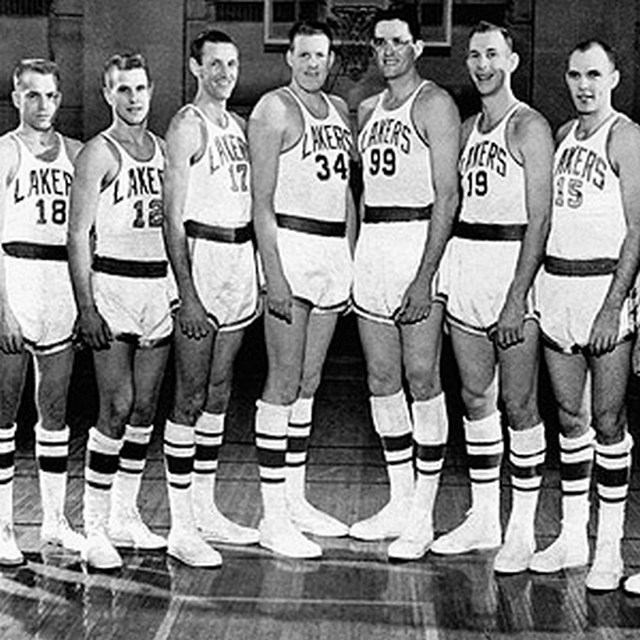

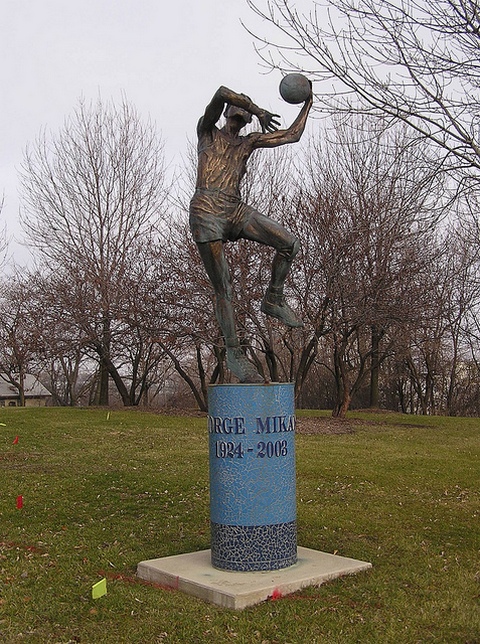


| Michael Schumacher: Mr. Basketball - GEORGE MIKAN Before Shaquille O'Neal and before Bill Russell, there was George Mikan, a six-foot-ten, 240-pound center, whose quiet demeanor and bespectacled face belied his competitive fire. A four-time All-American at DePaul and a six-time professional champion, Mikan was such an unstoppable force-and a national sensation-that, when his Minneapolis Lakers played the New York Knickerbockers in 1949, the marquee outside Madison Square Garden read simply, "George Mikan vs. Knicks." Drawing on extensive interviews-with former teammates, opponents, coaches, friends, and rivals-critically acclaimed author Michael Schumacher presents, for the first time, a wonderfully nuanced portrait of one of the most unheralded athletes of our time, and a fascinating look at the birth of the National Basketball Association.  Anybody who doesn't know who George Mikan is, is not a basketball fan. - Kevin Garnett Review of the book In his book "Mr Basketball - GEORGE MIKAN", Michael Schumacher explores the on-court life and legacy of George Mikan, the big man who revolutionized both college and professional basketball as a dominant center in the '40s and '50s and as the American Basketball Association's first commissioner in the 1960s. Several rules in the modern game were enacted to offset 6'10" Mikan's uncommon height advantage at the time: his shot-blocking ability for DePaul University led to the goaltending rule in college basketball in 1943, and his rebounding and scoring for the Minneapolis Lakers prompted the nascent NBA to widen the free-throw lane from six feet to 12 feet in 1951. Wilt Chamberlain described Mikan as the "first true superstar of the league," and Shaquille O'Neal, who paid for Mikan's funeral when he died in 2005 in dire financial straits due to the expenses of his health problems, said, "Without George Mikan, there is no me." A native of Joliet, Ill., Mikan was from a Croatian family and remained a true Midwesterner to the end, Schumacher writes. Schumacher's narrative sometimes gets bogged down with tedious, almost box score-like itemizing of the numerous games from Mikan. Source www.amazon.com |
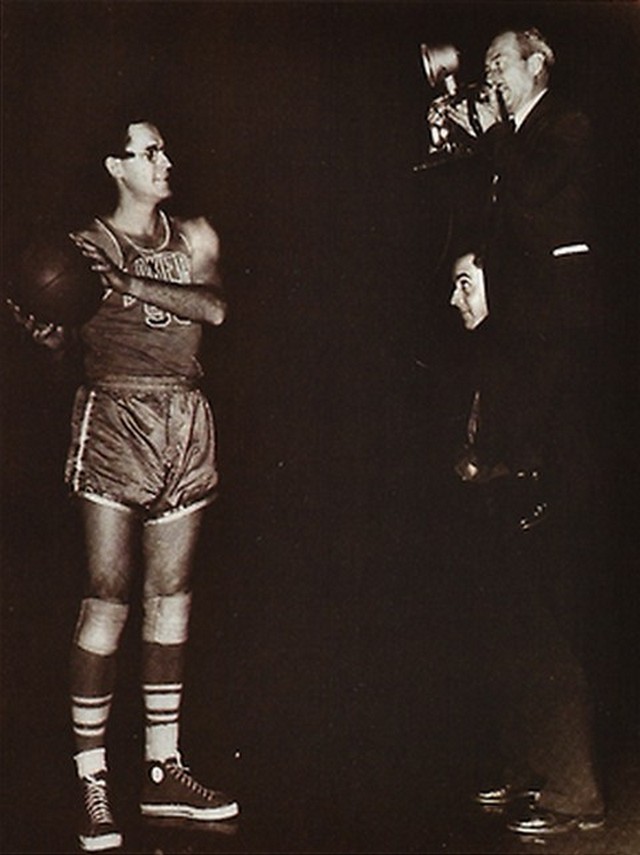
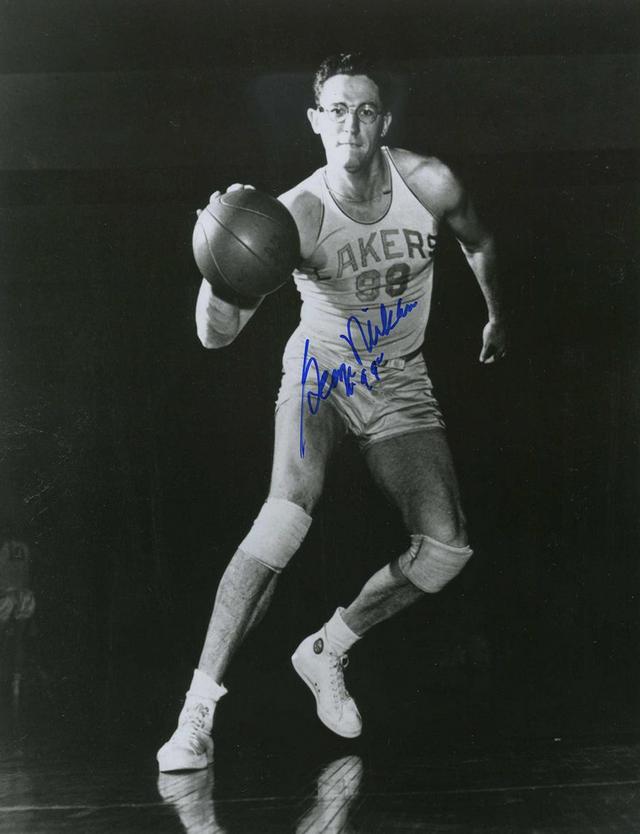
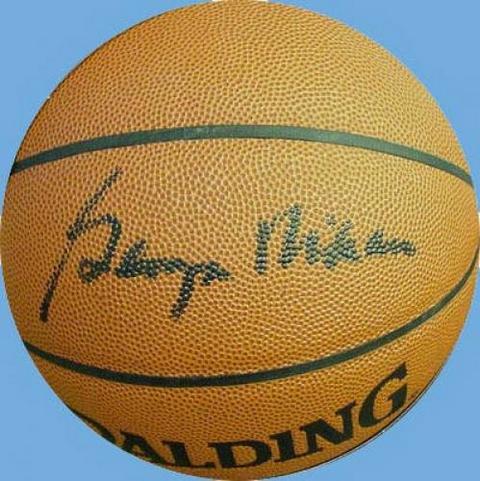
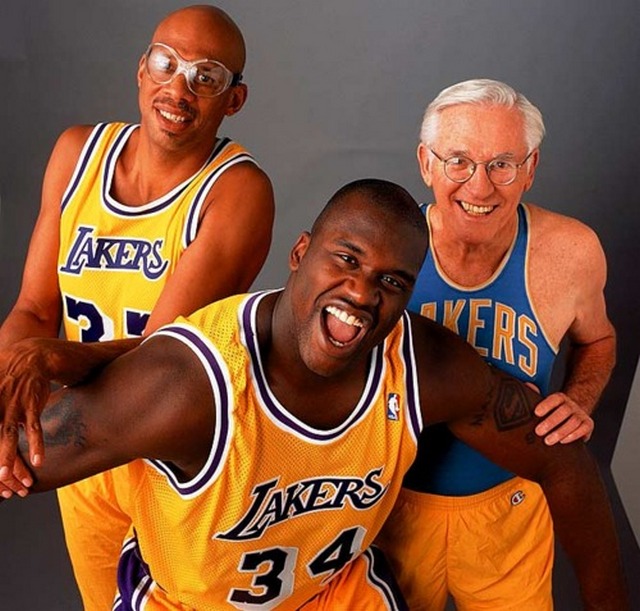

George Mikan pointing to the announcement, on the ladders.
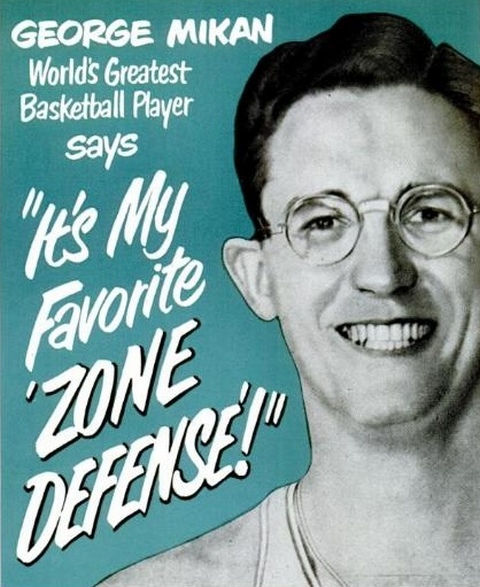
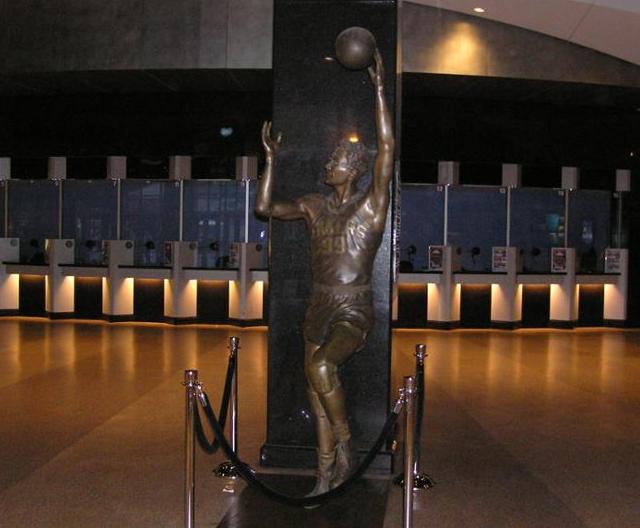
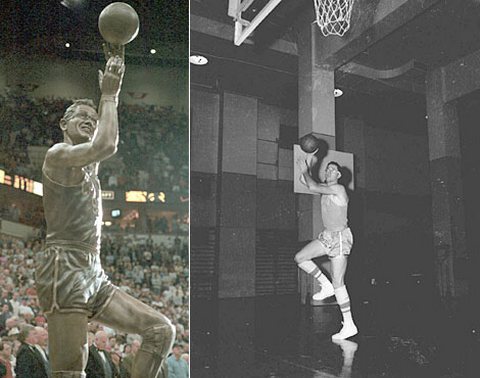
| George Mikan The irrepressible George Mikan, professional basketball's first dominant big man who led the Minneapolis Lakers to five championships, died at a Scottsdale, Arizona rehabilitation center, on Wednesday, June 1, 2005. He was 80. 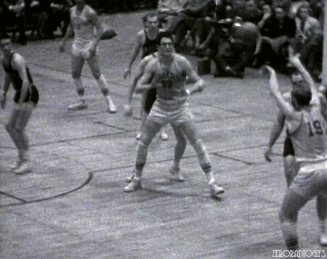 Mikan had suffered from diabetes and kidney failure and he was recently in the hospital for treatment of a diabetes wound in the his leg (his other legs was amputated several years ago). He also underwent kidney dialysis three days a week. A few days after he was moved from the hospital to the rehabilitation center, he passed away. Born June 18, 1924 in Joliet, Illinois, Mikan began his life on the hardwood at DePaul in Chicago. His devoted first-year coach, Ray Meyer, helped to mold Mikan into a star player, through various exercises and drills. The hard work eventually paid off and Mikan developed a legendary hook shot, which he was able to pull off with either hand. Six-foot-10, nearsighted with thick glasses, Mikan was so effective as a center at DePaul that he forced the NCAA to adopt the goaltending rule. As a professional, Mikan dominated from the moment he arrived. While playing with the Minneapolis Lakers, Mikan led his team to an astonishing five league titles in the first six years of the franchise's history. A rough player, Mikan led the league in personal fouls three times and had broke 10 bones during his playing career, yet for seven seasons he averaged 23.1 points per game. He earned the league title of MVP in the 1948-49 season, but retired in 1956 due to various injuries. "He obviously was the first of the real high-profile players," Boston Celtic great and CMG client Bob Cousy remarked. "He literally carried the league. He gave us recognition and acceptance when we were at the bottom of the totem pole in professional sports. He transcended the game. People came to see him as much as they came to see the game." Later in his life Mikan's love for basketball is not diminish. He coached the Lakers for a part of the 1957-58 season and was elected commissioner of the American Basketball Association in 1967. It was in this position that he introduced the 3-point line and the distinctive red, white and blue ball. "We were trying to get the network television contract, and I thought the typical brown ball was very hard to see in a large auditorium," Mikan said. "I decided on a ball with different-colored panels of red, white and blue for three reasons. First, it was patriotic; second, the TV viewability was just fantastic; and third, because of the salability of the ball. The young kids really liked it. In fact, we ran product comparison tests and the youngsters invariably chose our ball over the others." A statue was erected in honor of the NBA Hall of Famer at the Target Center in Minneapolis. George Mikan was truly one of the legendary greats as he graced the NCAA and NBA hardwood. His legacy and contributions to the great game of basketball will remain in the hearts and minds of individuals all over this great land. Mikan is survived by his wife of 58 years, Patricia; sons Larry, Terry, Patrick and Michael; daughters Trisha and Maureen, and numerous grandchildren and great-grandchildren. Source http://georgemikan.com/viewheadline.php?id=339 |
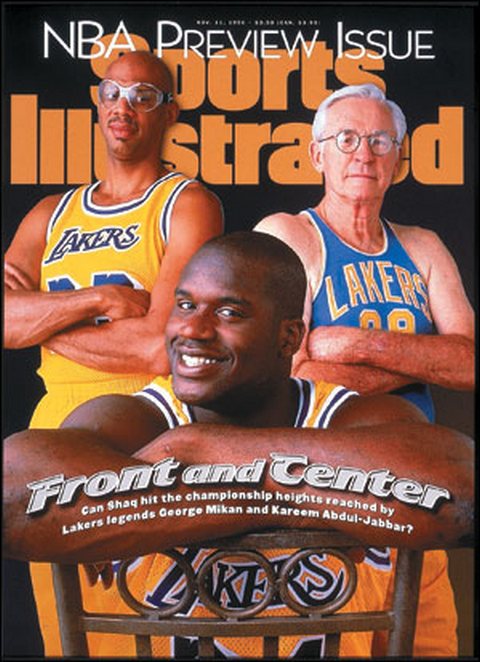
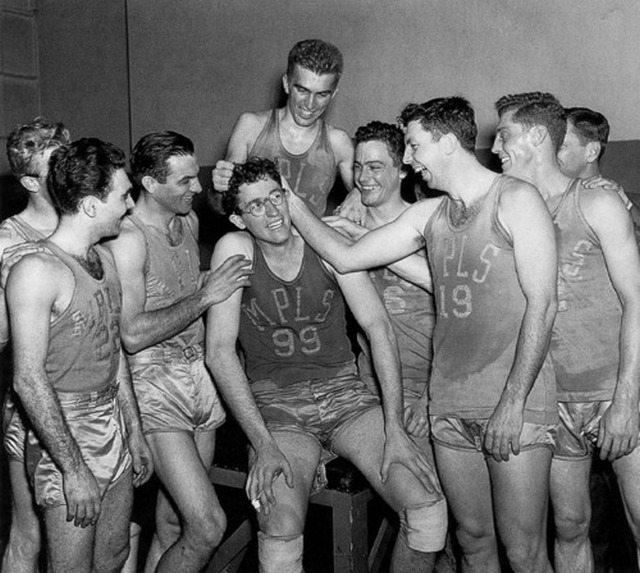
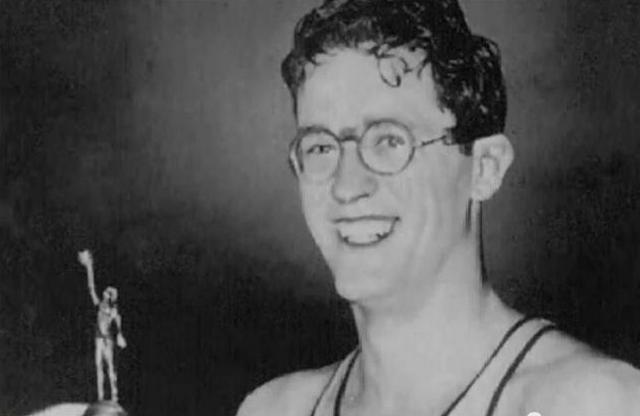

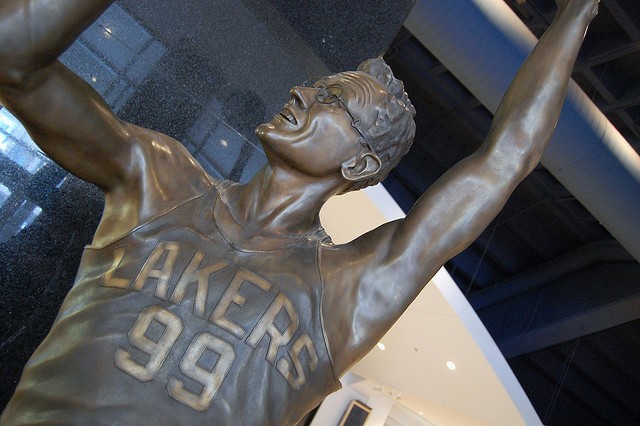
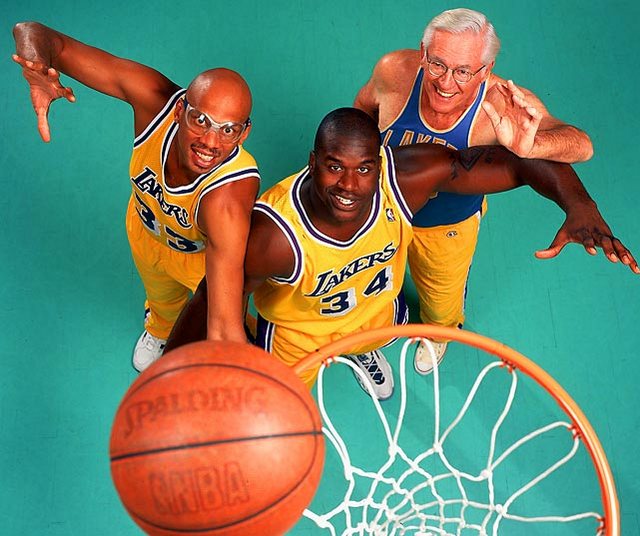
George Mikan Lakers Jersey Retirement Ceremony
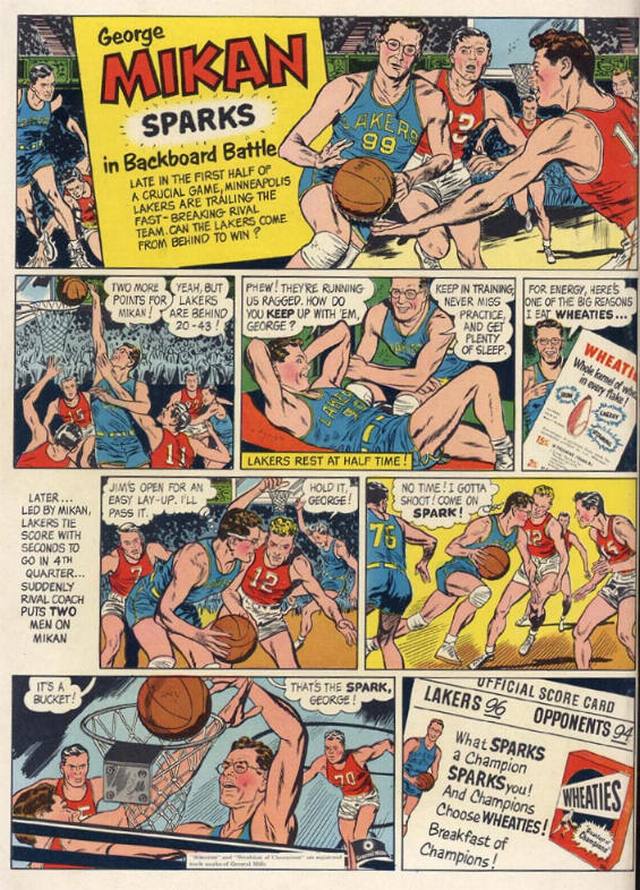
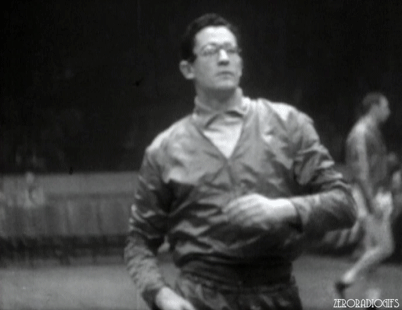
Formated for CROWN by Darko ®ubrinić
Distributed by www.Croatia.org . This message is intended for Croatian Associations/Institutions and their Friends in Croatia and in the World. The opinions/articles expressed on this list do not reflect personal opinions of the moderator. If the reader of this message is not the intended recipient, please delete or destroy all copies of this communication and please, let us know!